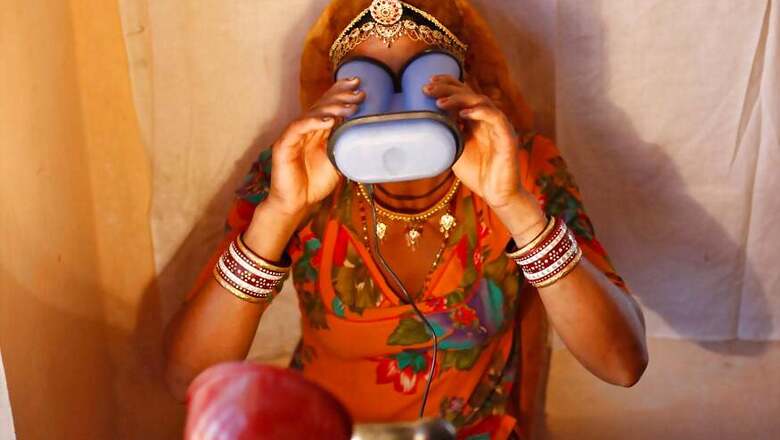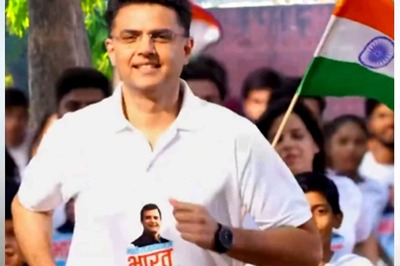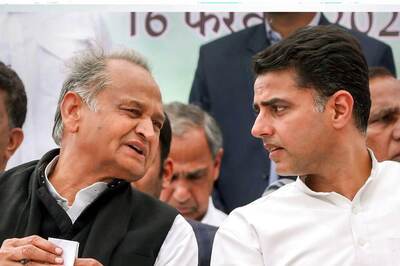
views
New Delhi: The Supreme Court is likely to pronounce its crucial verdict on Wednesday on whether the Centre's flagship Aadhaar scheme is compulsory. A five-judge constitution bench headed by Chief Justice Dipak Misra had on May 10 reserved the verdict on the matter after a marathon hearing that went on for 38 days, spanning four-and-half months. As many as 31 petitions, including one by former High Court judge K S Puttaswamy, have been filed. When the judgment was reserved by the court, Attorney General KK Venugopal had told the bench that this matter had become the "second longest" one in terms of days of hearing after the historic Kesavananda Bharati case of 1973. A key argument against the Aadhaar scheme was that it was violative of the nine-judge bench verdict that had held that Right to Privacy is a fundamental right under the Constitution.
Here’s a look what how the case has spanned so far:
When was the verdict reserved?
Through its order issued on May 10, the five-judge bench of the Supreme Court reserved judgment on the matter.
How many petitions were clubbed?
On May 10, a Constitution Bench finished hearing arguments from the batch of 29 petitions (led by K.S. Puttuswamy v. Union of India) that had challenged the constitutional validity of the Aadhaar scheme on various grounds.
What was the crux of the arguments put forth?
The petitioners tried to make a case that Aadhaar violated the fundamental right to privacy guaranteed under Article 21 of the Constitution, caused large scale exclusion of intended beneficiaries from various welfare schemes and benefits, and was irregularly introduced in Parliament as a money Bill to circumvent crucial oppositions.
When did the final hearing begin?
Final hearing of the petitions began on January 17, 2018 and spanned across 38 days.
What is the verdict expected to do?
When issued, the judgment will do one of three things:
1) Strike Aadhaar down as unconstitutional, forcing the government to dismantle the project and roll-back every initiative taken in connection with it
2) Find Aadhaar constitutionally sound, allowing the government to retain the project in its current form and expand it going forward
3) Arrive at a middle-ground, where certain aspects of Aadhaar are struck down and others retained. For instance, Aadhaar may be found constitutionally sound overall, but specific aspects like mandatory mobile/bank account linkages may be disallowed.
To begin with, who argued the case for petitioners and what was the basis to open the arguments?
Shyam Divan, Kapil Sibal, Gopal Subramaniam, KV Vishwanathan, Anand Grover, Sajan Poovayya, Meenakshi Arora, PV Surendranath, CU Singh, Sanjay Hegde, NS Nappinai, P Chidambaram, Prasanth Sugathan, Jayana Kothari and Arvind Datar, all senior advocates, were the counsel for petitioners. Petitions challenged the Aadhaar scheme and the project, the 2016 statute, notifications, regulations, circulars, etc primary issue that arose was whether the project was constitutional at all. The second issue was that the statute itself was under challenge on several grounds including violation of Part III of the Constitution.
What were they key points of the petitioners in the marathon Aadhaar hearing?
— Aadhaar was operating as an instrument of exclusion: It was stated that people have been facing several difficulties due to the problems in enrolment. The people living in remote areas of the country were unable to come to the enrolment centres. People involved in manual labour were unable to get their biometrics registered.
— Aadhaar as a tool for surveillance in real time: The process of authentication was laid down and how every authentication transaction leaves an electronic trail which enables location when built up over time. Arguments on how different silos of information was taken and Aadhaar allowed for convergence of these information which might help in profiling.
— Privacy is the constitutive core of human dignity and the foundation of ordered liberty: It recognises the individual’s right to control vital aspects of their life. It is not lost or surrendered merely by being in a public place.
— Civil death of someone by deactivating Aadhaar: Constitution is not about the power of the State but about limits to that power. Aadhaar allows the State to dominate the individual through an architecture that enables profiling, and by the power to cause civil death by deactivating Aadhaar.
— There is no informed consent. There is no opt-out option. UIDAI has no direct relationship with the collecting agencies. The data collected and stored lacks integrity.
— Biometrics are untested, and probabilistic. The use of biometrics has led to exclusion from welfare schemes. If biometrics don’t work, then a flesh and blood individual ceases to exist. If your biometrics don’t match, you become a ghost.
— Aadhaar does not allow people with an option to opt-out. If a person has given her biometrics, she should have a concomitant right to opt out. Reasons were cited as to why the people do not wish to continue with Aadhaar and wanted to opt out of Aadhaar and have all their enrolment and authentication records deleted.
— Biometric, core biometric and demographic info of an individual, once part of the digital world is irretrievable. No legislation can or should allow an individual’s personal data to be put at risk in the absence of a technologically assured and safe environment.
— Aadhaar has become much more than an identity programme today. It is now an “identity plus” where the “plus” includes metadata gathering and monitoring. Sections 3, 4, 8 and 57, rather than Section 7 of the Act are the key provisions to be considered. What Section 7 seeks to do could have been done just as well under the Food Security Act.
— Present Act takes away the right of the individuals to freely mobilise and hence, constitutes an infringement. The ability to negate the personhood causes not just civil death but also constitutional death which is impossible to conceive.
— Aadhaar Act has an element of objectification. It depersonalises an individual and eliminates any form of transaction except through the medium of this Act. A person can exist independent of Aadhaar and if the Act cannot accommodate that possibility then it is not just.
— Delegated legislation cannot be ratified by a subsequent legislation when it has resulted in violation of fundamental rights.
— Procedure adopted by Parliament is illegal and unconstitutional. It will be open to scrutiny in a court of law. Upper House in a bicameral legislature cannot be bypassed as it plays an important role in a federal Constitution.
Whether the individual's decision about how to use her body can be taken over by the State, who decides for her instead?
— Section 7 of the Act had resulted in the exclusion of most marginalised sections of the society and hence in unconstitutional and violative of Article 14
— Government savings and better targeting does not justify the infringement of rights, it is hugely disproportionate. State could have adopted less intrusive alternative measures to achieve the same purpose.
— Surveillance can give a 360 degree view into an individual’s life. It is a cloak of mass surveillance, democracy can be destroyed rather than protected.
— Aadhaar project impinged upon the right to dignity of the individuals as it amounted to requiring a licence for exercise of fundamental rights
— Under the Indian law, a child cannot give consent or enter into a contract. It was argued that a child cannot be deemed to have given consent under Aadhaar which involves parting with data permanently.
— Aadhaar Act discriminated against sexual minorities
— Aadhaar will not survive the first five words of the Preamble, “We, the people of India.”
— Data of citizens cannot be used for political exercise and Aadhaar’s preponderant nature is” likely to invade. It changes the symbiotic relationship between State and citizen.
How did government defend the Aadhaar Act
The case for the state was argued by Attorney General KK Venugopal, senior advocate Rakesh Dwivedi, Jayant Bhushan, Additional Solicitor General, Tushar Mehta, and advocate Gopal Sankarnarayanan
— Architecture of the Act was designed in a manner that privacy is infringed as little as possible
— From 2009 to 2016, Aadhaar was completely voluntary, but people still signed up for it.
— Section 12 of the National Food Security Act also envisaged Aadhaar for targeted distribution of food grains and to record transparent delivery of the same. Binoy Viswam vs Union of India cited to show how Aadhaar prevented multiple identities and provides one unique identity.
—Stressed on the significance of having an ‘identity’ and remarked that official identification is more than a convenience. It is a fundamental human right, and helps in economic development, participation in electoral process, and also helps the government in providing benefits to the people.
—PowerPoint Presentation: Ajay Bhushan Pandey, CEO of UIDAI, stated Aadhaar is a completely random number, and once issued, it is never issued again, even if the Aadhaar holder dies
— Ecosystem comprises of decentralised enrolment and centralised storage of data. The type of encryption that is used is 2048-bit and the traceability of all actors in the enrolment process is ensured through audit trail.
— Every Aadhaar card has a QR code, which on scanning shows the Aadhaar card holder’s photograph, therefore, there is no question of de-duplication.
— Aadhaar is an evolving technology and all other alternatives were considered for a period of more than five years before the project was finally decided upon. Aadhaar Act can be amended and rectified according to the changing time
— Every Aadhaar enrolment at an enrolment center passes through an human eye and if not found to be proper is asked to re-enrol
— Biometric authentication is based on 1:1 matching and therefore in that sense is not probabilistic
— Right is not absolute and the State can always enforce reasonable restrictions to protect legitimate state interests
— Right to Life trumps Right to Privacy
— No question with regard to privacy in the present case and the actual challenge is whether Aadhaar is safe and secure
—Biometrics technology is a safe and secure way to combat issues such as money laundering, bank frauds, income tax evasion and providing direct subsidies to beneficiaries
— State has no interest in collection of biometrics except for the benefit of the individual himself
— An individual can easily evade taxes by saying that they do not have a PAN, he argued. Aadhaar-PAN linkage will prevent such tax evasion
— Link bank account with Aadhaar because terror financing destroys the root of our democracy and threatens national security.
— Under section 8 of the Aadhaar act, individuals’ information is strictly confined to the purpose of authentication and the interplay of sections 8 and 29 mean that core biometrics i.e. fingerprints and iris scans are not shared with any third party
— Aadhaar is not just an exercise to provide benefits and weed out fakes but also to bring the service providers face to face with the beneficiaries
— Court of Justice of the European Union (CJEU) and the European Court of Human Rights (ECHR) have never expressed any concerns with biometrics ID cards
— UIDAI has device control, there are double pairs of keys, encryption is immediate and time stamped, transmission of data requires a digital signature with a private key, there is complete prohibition of storing PID block and finally there are penal consequences if any provision of the Aadhaar Act or Regulations is violated.
— Aadhaar Act passage justified as money bill because Section 7 of the Act of 2016, necessitating the proof of Aadhaar number for availing ‘subsidies, benefits and services’ the expenditure whereon or the receipts wherefrom is debited or credited, as the case may be, to the Consolidated Fund of India.



















Comments
0 comment